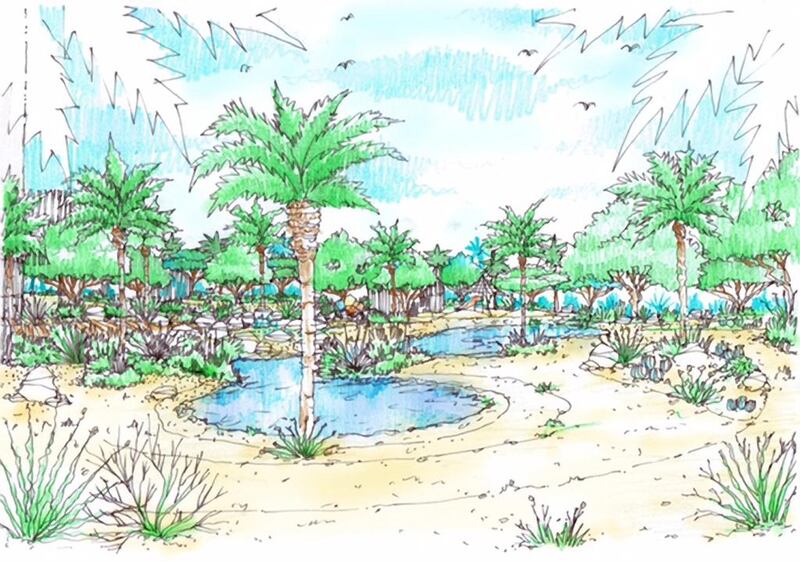'I don't think I will ever complain about rain again," says Alan Titchmarsh, as he surveys the wild and untouched desert landscape in front of him. "It makes me think how lucky I am."
For his fellow Brits, gardening is more likely to be about a surfeit of rain and drizzle, rather than strategies to tackle a lack of it.
Emirati landscape designer Kamelia Zaal has brought Titchmarsh on a tour of Al Barari to see what can be crafted and planted in a desert environment – and to show that, if you have will, skill and water to hand, the landscape can be entirely transformed.
Yet Zaal’s most recent garden design, which can be found at Canvas, a new development by Koa, adjacent to Al Barari, uses indigenous and naturalised plant species and aims to craft a design that works with the prevailing environment, by consuming just 10 per cent to 20 per cent of the water required by conventional planting designs.
In doing so, Zaal is attempting to create a new design aesthetic, in much the same way that renown Brazilian landscape architect Roberto Burle Marx did when he collected and propagated plant species found in the local landscape and redeployed them in his design schemes. He made people look in a new way at what was already familiar, and Zaal’s scheme seeks to do something similar by designing with plant species already found in the UAE’s desert landscapes.
-----------------------------
[ Examples of indigenous plants being used by Kamelia Zaal - in pictures ]
-----------------------------
It’s still early days for the scheme – designers usually work on a three-to-five-year cycle for their designs to reach maturity. Zaal admits that two months after the first wave of planting, the garden is still something of a prototype and the planting is experimental. She has found it difficult to achieve the density that she wanted for her plan, given the size of the specimens available, so the numbers were increased four-fold. Zaal isn’t replicating what’s found in nature here – she’s designing with its influence.
Bruce Pedersen, nursery production manager and sales and technical manager at Marmara International Landscaping, sourced most of the indigenous plant species for Zaal’s planting plan from Barari Nurseries in Al Ain, while other plants were brought in from Marmara’s own nursery and the site at Al Barari.
He explains that indigenous plants are defined as “those that have originated in, or are characteristic to, a specific region or area; they are there by virtue of natural distribution processes without the aid of human intervention”.
Conversely, a number of naturalised or introduced species also form part of the design. These are “plants that have been introduced into an area [through human intervention] from outside of its normal distribution range, and where through the nature of the particular plant or the environment they are able to survive and flourish”. These include Ficus cordata, Vitex agnus-castus, Agave americana, Pennisetum divisum, Punica granatum and Parkinsonia aculeata.
In some instances, naturalised plant species may have been growing in this region for many hundreds of years, but will still not be defined as indigenous.
Getting indigenous plants to thrive outside of their original location requires an out-of-the-box mindset. These plants don’t behave as ordinary plants behave – they can’t, because they have to endure long periods of aridity, salinity, high temperatures and sometimes burning winds.
Many of the indigenous specimens produce their seed in the middle of summer, a further challenge for the plantsman collecting from the desert. Pedersen reflects that a lot of trial and error has been necessary to reach effective propagation – taking cuttings, using rooting powders and experimenting with different soils – yet even when plants are finally underway, a caretaker may overwater and an entire batch can be lost.
Consequently, while water costs for maintaining such schemes may be low, plant-specimen prices are four to five times higher per square foot compared with other plants, reflecting the research and development investment that has been made to date. It’s anticipated that in time, as commercial demand for these species and production increases, costs will decrease.
As we leave the site, Titchmarsh reflects that “plants make sense of place”. Without them, there are only buildings, with nothing to connect them or knit the landscape with the constructed. Zaal’s most recent design redefines that sense of place by distilling the essence of the wider environment, and giving new focus to what has been here all along.
homes@thenational.ae





